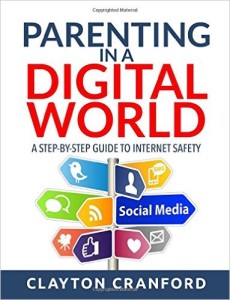As a school resource officer, Clayton Cranford has experienced the darker side of technology in the lives of children and teens.
Having worked on issues of cyberbullying, online predators, and sex trafficking, the “Cyber Safety Cop” (as he’s known) has distilled much of that experience into an immensely practical book for parents. Parenting in a Digital World: A Step-by-step Guide to Internet Safety is a small warehouse of internet safety information for those of us raising digital children.
What’s inside
 Immediately, the book gives parents a “Cyber Safety Cop plan”: a checklist of items and action steps to increase online safety for their kids. Cranford follows that with his version of an internet and mobile contract, which could be used as is or modified easily.
Immediately, the book gives parents a “Cyber Safety Cop plan”: a checklist of items and action steps to increase online safety for their kids. Cranford follows that with his version of an internet and mobile contract, which could be used as is or modified easily.
Next, there are brief overviews of social media, online reputation, and age-appropriateness, followed by a chapter on online predators, and one on cyberbullying. “Chapter” is perhaps misleading; these sections are often just a couple of very succinct, informative pages that read more like a stand-alone article.
The remainder of the book is the most practical section and comprises the majority of its pages. Cranford gives us brief summaries of over 20 social media apps, and includes their general use, their “official” age limits, and the red flags parents should know. Then, he walks us through the parental controls and privacy settings for a couple dozen of the most popular game systems, operating systems (including Chromebooks!), safe searches, and social media accounts. This is done in full color, step-by-step, screen-by-screen tutorial style.
The book concludes with a directory of all the contact information needed for reporting abuse or cyberbullying for a dizzying number of social media companies, internet providers, popular websites, and cell phone services.
My take
There is simply no fluff in this book. Cranford gets to the point on the most pressing tech issues facing parents right now.
In the early part of the book, each section reads like an article or blog post, and information is well-cited and illustrated. While chapters don’t always flow smoothly from one to the next, and the book seems to jump around a little, each topic that he tackles is completely on point and relevant to today’s parents. These are subjects that, as parents, we need to hear. Indeed, most of the book is a packed reference that parents will repeatedly find themselves reaching for.
I bought a copy in the fall, but went back to it recently when my boys received a new gaming system for Christmas. I started in on the parental controls and thought “Wait, I don’t have to pick my way through this!” and grabbed my copy. Slick.
The greatest strength of Parenting in a Digital World is that it is immensely actionable. Some of the topical chapters at the beginning even conclude with a list of action items. Of course, the parental controls section is all about the steps to take to make online access safer.
In this visually appealing, information-rich book, Cranford has given parents a solid reference and clear steps to take to strengthen the digital fence around our families. While the tone leans a little heavily towards fear and the scarier aspects of tech, Cranford speaks from hard-earned experiences with aspects of our online world most of us never see. As parents, we would do well to listen to him and follow his advice in keeping our kids safer online.
